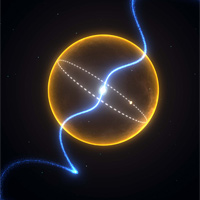Doodling Shake Bot DIY STEM Kit
$9.99$5.95
Posted on: Aug 31, 2011

Pulsar planet
A once-massive star that’s been transformed into a small planet made of diamond: that’s what astronomers think they’ve found in our Milky Way.
The discovery, reported in Science August 26th, was made by an international research team led by Professor Matthew Bailes, Pro Vice-Chancellor (Research) at Swinburne University of Technology in Melbourne and the ‘Dynamic Universe’ theme leader in a new wide-field astronomy initiative, the ARC Centre of Excellence for All-sky Astrophysics (CAASTRO).
The researchers, from Australia, Germany, Italy, the UK and the USA, first detected an unusual star called a pulsar using the CSIRO Parkes radio telescope and followed up their discovery with the Lovell radio telescope in the UK and one of the Keck telescopes in Hawaii.
Pulsars are small spinning stars about 20 km in diameter—the size of a small city—that emit a beam of radio waves. As the star spins and the radio beam sweeps repeatedly over Earth, radio telescopes detect a regular pattern of radio pulses.
For the newly discovered pulsar, known as PSR J1719-1438, the astronomers noticed that the arrival times of the pulses were systematically modulated. They concluded that this was due to the gravitational pull of a small companion planet, orbiting the pulsar in a binary system.
The pulsar and its planet are part of the Milky Way’s plane of stars and lie 4,000 light-years away in the constellation of Serpens (the Snake). The system is about an eighth of the way towards the Galactic Centre from the Earth.
The modulations in the radio pulses tell astronomers several things about the planet.
First, it orbits the pulsar in just two hours and ten minutes, and the distance between the two objects is 600,000 km—a little less than the radius of our Sun.
Second, the companion must be small, less than 60,000 km (that’s about five times the Earth’s diameter). The planet is so close to the pulsar that, if it were any bigger, it would be ripped apart by the pulsar’s gravity.
But despite its small size, the planet has slightly more mass than Jupiter.
'This high density of the planet provides a clue to its origin,' said Professor Bailes.
A star is torn
The team thinks that the ‘diamond planet’ is all that remains of a once-massive star, most of whose matter was siphoned off towards the pulsar.
Pulsar J1719-1438 is a very fast-spinning pulsar—what’s called a millisecond pulsar. Amazingly, it rotates more than 10,000 times per minute, has a mass of about 1.4 times that of our Sun but is only 20 km in diameter. About 70 per cent of millisecond pulsars have companions of some kind. Astronomers think it is the companion that, in its star form, transforms an old, dead pulsar into a millisecond pulsar by transferring matter and spinning it up to a very high speed. The result is a fast-spinning millisecond pulsar with a shrunken companion—most often a so-called white dwarf.
'We know of a few other systems, called ultra-compact low-mass X-ray binaries, that are likely to be evolving according to this scenario and may likely represent the progenitors of a pulsar like J1719-1438,' said team member Dr Andrea Possenti, Director of the INAF-Osservatorio Astronomico di Cagliari in Italy.
But pulsar J1719-1438 and its companion are so close together that the companion can only be a very stripped-down white dwarf, one that has lost its outer layers and over 99.9 per cent of its original mass.
'This remnant is likely to be largely carbon and oxygen, because a star made of lighter elements like hydrogen and helium would be too big to fit the measured orbiting times,' said Dr Michael Keith (CSIRO), one of the research team members.
The density means that this material is certain to be crystalline: that is, a large part of the star may be similar to a diamond.
'The ultimate fate of the binary is determined by the mass and orbital period of the donor star at the time of mass transfer. The rarity of millisecond pulsars with planet-mass companions means that producing such ‘exotic planets’ is the exception rather than the rule, and requires special circumstances,' said Dr Benjamin Stappers from the University of Manchester.
The team found pulsar J1719-1438 among almost 200,000 Gigabytes of data using special codes on supercomputers at Swinburne University of Technology, The University of Manchester, and the INAF-Osservatorio Astronomico di Cagliari..
The discovery was made during a systematic search for pulsars over the whole sky that also involves the 100 metre Effelsberg radio telescope of the Max-Planck-Institute for Radioastronomy (MPIfR) in Germany. 'This is the largest and most sensitive survey of this type ever conducted. We expected to find exciting things, and it is great to see it happening. There is more to come!' said Professor Michael Kramer, Director of the MPIfR.
Professor Matthew Bailes is a member of the Centre for Astrophysics and Supercomputing at Swinburne which is uniquely resourced to process the torrents of data generated by telescopes and simulations.
A video of Professor Bailes explaining the 'diamond planet' discovery can be viewed on Swinburne's YouTube channel.
Publication:
M. Bailes et al. [17 co-authors] 'Transformation of a Star into a Planet in a Millisecond Pulsar Binary,' published in Science.
 'He who finds a thought that lets us even a little deeper into the eternal mystery of nature has been granted great grace.'
'He who finds a thought that lets us even a little deeper into the eternal mystery of nature has been granted great grace.'